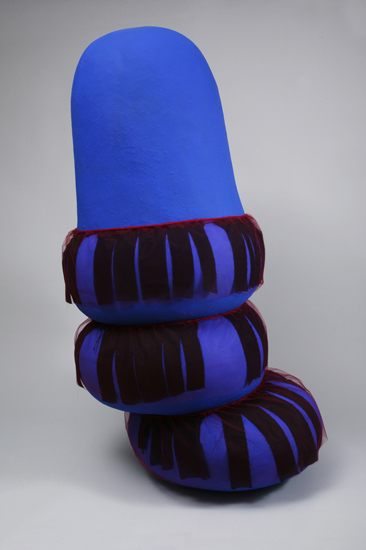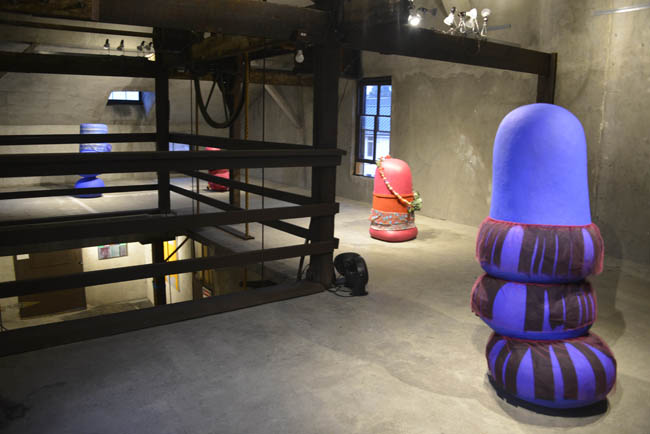All Dressed Up and Everywhere to Go
Deborah Garfinkle
November 2016
Miriam Bloom: Sculpture
Wherever You Roam
John Davis Gallery
 Installation shot from Wherever You Roam, photo courtesy of Maryna Bilak
Installation shot from Wherever You Roam, photo courtesy of Maryna Bilak
Life’s splendor forever lies in wait about each one of us in all its fullness, but veiled from view, deep down, invisible, far off. It is there, though, not hostile, not reluctant, not deaf. If you summon it by the right word, by its right name, it will come.
Franz Kafka
There is, however, in art another kind of external similarity which is founded on a fundamental truth. When there is a similarity of inner tendency in the whole moral and spiritual atmosphere, a similarity of ideals, at first closely pursued but later lost to sight, a similarity in the inner feeling of any one period to that of another, the logical result will be a revival of the external forms which served to express those inner feelings in an earlier age. An example of this today is our sympathy, our spiritual relationship, with the Primitives. Like ourselves, these artists sought to express in their work only internal truths, renouncing in consequence all consideration of external form.
Wassily Kandinsky
Miriam Bloom’s show, Wherever You Roam, sculptures recently on view at the John Davis Gallery in Hudson, New York bring us on a timeless journey that is simultaneously material, conceptual, philosophical and spiritual. These multimedia works play with the fabric that expresses the infinite, ever-changing and often contradictory incarnations governing being: body and soul, destruction and creation, dream and reality, the sacred and profane, sense and non-sense, fullness and emptiness, innocence and knowing, antiquity and modernity, stasis and movement, high art and child’s play. Bloom’s powerful and moving constructions dare us to question the narratives we impose on works of art; our tyrannical penchant for turning independent forms into knickknacks gathering dust in the safety and security of our living rooms; mirrors that reflect our own idealized images of ourselves, screens on which we project all our aspirations, hopes, and desires. Such works of art succumb to our vanity; they are enslaved by our desire to, in the manner Humbert Humbert does Lolita, solipsize, impose a self-referential reality on another form of being. By asserting our will over these figures, we lose what they can narrate to us of their own self-realizations, the inner light that emanates from a deep place within that strives to be released, that has aspirations to connect to that which is without.
Yet Bloom’s work defies conquest because it expresses the aspiration of form, the potential to be at one fleeting moment before moving on someplace else. How can you stake a claim when the territory is no longer there? They have been liberated from external concerns about aesthetics to get at the inner reaches of what being can celebrate in form and material. Not down the line in a linear fashion, but to another dimension, another state, another way of expression at the juncture where non-representation blossoms into representation and back again into the stuff of our dreams, journeys that take us down high roads, low roads, roads traveled, less traveled and never traveled with humor, joy, awe and poetry.
 Everything That Happens Will Happen Today
Everything That Happens Will Happen Today
photo courtesy of Michael Musante
Elements of these journeys are embodied in works like Everything That Happens Will Happen Today, where we feel the figurative and visceral “clash between the high and low, travesty and friction” that imbues the work. The form, drenched in blue, suggests a lingam, the ancient representation of the Hindu god, Shiva, who holds the key to both creation and destruction; the potential to engender, the potential to raze. Yet, in this manifestation, the phallic symbol has not been hewn from impervious stone and left naked and bare to be adorned by worshippers; instead Bloom has constructed the figure out of layer upon layer of paper, the medium bulked up to belie its elemental fragility. Bloom then dresses her figure in black silk and red tulle, initiating a dialogic conversation between what Bloom characterizes as “ideal, formal sculptural concerns” and “the temporary, sociological language of clothing.” The effect of this convergence of idioms is, as Chris Atman observes, “both very familiar and also humorously eccentric,” the tulle and silk (a tutu on the god?) the stuff of child’s play, our dumb attempts at articulating the timeless beauty of the immortals with the simple materials we innocent mortals have at hand to prettify them. This holds true also in the case of Nothing With Something Around It, the lipstick red form suggestive of Shakti, the feminine force to Shiva’s masculine, cloaked in wool and cloth, then bedecked with plastic floral garlands.
These soft classical forms dressed playfully up remind us how desperately we desire to clothe our gods so they can be like us, vulnerable to the elements, yet illuminated by our imagination and the dreams that take us to worlds we’ve yet to explore and conquer where we, too, can be as the gods; when we’re bored with one manifestation, we get a new bee on our bonnet and play that we are someone, something else altogether than what we were just a few moments before. It is like that with our faith that is forever locked in the process of transforming itself so that we can go on in life knowing that playtime will ultimately end. Yet the gods and goddesses of our human souls, springing from the blue void and red flames of the forge, will go on to worship at other altars, play other games. What stays the same is the will to push our boundaries to the very limit of what defines our being, the submission to impermanence and the desire to freely roam through the world with no set goal because, as the cliché goes, it’s all in the journey. And those figures we conceive along the way to the truth, like our gods, accompany our dreams, our desires, our life, as we their dreams, their aspirations, their life.
 Installation shot from Wherever You Roam, photo courtesy of Maryna Bilak
Installation shot from Wherever You Roam, photo courtesy of Maryna Bilak
Wherever You Roam
Miriam Bloom
Sculpture
John Davis Gallery
Hudson, New York
September 17-October 9, 2016

Congrats Miriam, he work looks truly great, sorry I cannot see it for real. Any other photo’s
thank you for posting these images. had wanted to get up there, but was not possible. have a wonderful day.